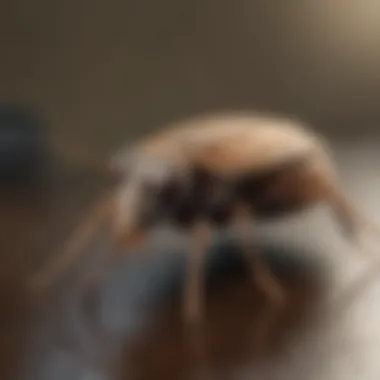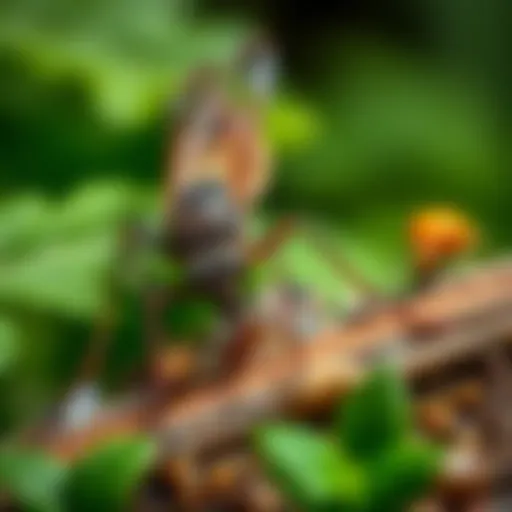Expert Insights on Northern Virginia Exterminators


Intro
Pests can create significant discomfort and disruption in homes, especially in regions like Northern Virginia, where various species thrive. Homeowners and renters often find themselves at a crossroads when faced with pest infestations. This article aims to demystify the world of pest control in Northern Virginia, providing essential insights into the ecosystem of local exterminators. By exploring pest identification, prevention strategies, and treatment options, we provide a framework to understand how to deal with common pest issues effectively.
Pest Identification
Effective pest control begins with a solid foundation in pest identification. Recognizing the type of pest and understanding its behavior are essential steps toward implementing successful management strategies.
Detailed Descriptions of Common Pests
Some of the most frequently encountered pests in Northern Virginia include:
- Termites: These silent wood-eaters can cause severe structural damage. They thrive in humid conditions, often making their presence known when the damage is already done.
- Rodents: Mice and rats are notorious for their ability to invade homes. They can contaminate food and spread disease.
- Ants: Various species are prevalent in the area, including carpenter ants and red imported fire ants. They tend to invade kitchens, drawn by food and water sources.
- Bed Bugs: These pests are increasingly common in urban settings. They are known for causing discomfort and are challenging to eliminate.
Signs and Symptoms of Infestations
It is crucial for homeowners to know what signs to look for. Common indicators that you might be experiencing a pest infestation include:
- Droppings or fecal matter in and around the home.
- Gnaw marks on food containers or wood.
- Unusual noises, especially at night (indicative of rodents).
- Visible nests or trails around entry points.
- Itchy bites on the skin (common with bed bugs).
"Early detection is key to preventing significant pest problems. Addressing signs promptly can save time and resources in pest control efforts."
Prevention Strategies
The best pest control strategy often lies in prevention. Understanding the interplay between the environment, home maintenance, and pest behavior can significantly reduce the chances of infestations.
Home Maintenance Tips for Pest Prevention
Regular upkeep of one’s residence can help thwart potential pest invasions. Consider these strategies:
- Seal cracks and crevices in windows and doors to deter entry.
- Ensure proper drainage systems to avoid standing water, which attracts mosquitoes and other pests.
- Keep the kitchen clean and store food in airtight containers.
- Regularly declutter spaces to minimize nests and hiding spots.
Natural Deterrents and Barriers
Some homeowners prefer environmental-friendly approaches to pest prevention. Effective deterrents include:
- Diatomaceous Earth: Spread around entry points can keep insects at bay.
- Essential Oils: Scents like peppermint and tea tree can repel many pests.
- Physical Barriers: Installing screens on windows and doors can help prevent entry by various insects.
Treatment Options
When prevention fails, treatment becomes necessary. Understanding the different treatment options available can help homeowners make informed decisions.
Overview of Chemical vs. Natural Treatments
Pest control treatments can be broadly categorized into chemical and natural options. Chemical treatments often provide quick results but may involve health risks or environmental concerns. In contrast, natural treatments tend to be safer but may require more time and repeat applications to be effective.
Step-by-Step Guides for DIY Treatments
For those who choose to address infestations themselves, here are some general steps:
- Identify the Pest: Use available resources or consult with local exterminators to correctly determine the pest type.
- Research Treatment Options: Determine the most effective approach based on the pest type, availability of treatments, and safety considerations.
- Apply Treatment: Follow manufacturer instructions carefully if using chemicals. For natural treatments, ensure proper application methods are employed.
- Monitor: After treatment, carefully observe the area for any signs of pest activity.
- Reevaluate: If pests persist, consult with a professional exterminator.
In summary, navigating the complexities of pest control in Northern Virginia requires a blend of knowledge, vigilance, and appropriate action. By understanding local pest dynamics, aspiring to prevent infestations, and knowing when to engage professionals, homeowners can maintain a pest-free environment.
Understanding Pest Control in Northern Virginia
Pest control is crucial for maintaining the health and safety of homes in Northern Virginia. This region is particularly prone to various nuisances and damaging pests due to its unique climate and geographic features. Understanding pest control involves not only knowing what pests are common but also recognizing the methods available for their management. This understanding is beneficial for homeowners.
Knowledge about pest control can help prevent infestations before they occur, making it essential for a healthy living environment. Additionally, effective pest control practices reduce the risk of property damage and health issues associated with pest-related diseases.
People should be aware of the various pest types that inhabit their area, most notably termites, ants, rodents, and spiders. By grasping the importance of pest control, homeowners can ensure that they are proactive, rather than reactive, in maintaining their households.


Regional Pest Challenges
The challenges of pest control in Northern Virginia are varied. Proximity to woodlands and rivers creates habitats for various insects and animals. This interconnected ecosystem can make your property vulnerable to pests that seek shelter or food indoors. Some prevalent challenges here are the local termite population, which can cause significant structural damage, and the seasonal influx of ants and rodents that can invade homes.
Homeowners need to consider these challenges while planning pest control strategies. Ignorance of these regional threats can lead to more substantial infestations and higher costs for extermination work.
Common Pests in Northern Virginia
Termites
Termites are a significant threat in Northern Virginia, mainly due to the region's climate, which is conducive to termite activity. These pests can silently destroy the wood structure in homes. Their ability to go unnoticed until significant damage occurs makes them a persistent concern. Terminates can contribute negatively to wooden structures, making it critical for homeowners to invest in preventative measures and regular inspections. The risk of significant financial loss is a considerable disadvantage associated with their presence.
Ants
Ants are another common pest in the region, especially during warmer months when they invade homes in large colonies. Their ability to find food and shelter quickly makes them a recurring issue. Ants typically are not harmful to health, but their presence can be annoying. Different species may enter homes for various reasons, altering the approach homeowners should take in managing them. Being educated on how to identify and eliminate ant trails is an essential aspect of pest control.
Rodents
Rodents, including mice and rats, are rampant in Northern Virginia, particularly in urban and suburban areas. They can reproduce quickly and infest homes, leading to structural damage and health risks due to contamination of food sources. Key characteristics of rodents include their agility and ability to fit through small openings, which makes them hard to contain once they enter a property.
Understanding rodent behavior is vital in developing effective control methods to minimize their impact.
Spiders
Spiders are prevalent in many homes, often being misunderstood. While most spiders are harmless, some, like the black widow or brown recluse, can pose health risks. They typically enter homes seeking shelter. Their control can be complicated, as improper methods may lead to increased populations. Educating oneself about local spider species is important for assessing risk and engaging in appropriate control techniques.
Impact of Weather Patterns
Weather plays a significant role in pest populations. The dampness of Northern Virginia's spring creates a perfect environment for many pests, leading to increased activity. Hot summers can attract various insects, escalating infestations in homes. Seasonal changes are correlated with pest behavior, meaning that awareness of these patterns can lead to timely preventive actions. Homeowners can manage pest control better by understanding how weather affects pest populations.
The Role of Exterminators
The role of exterminators in a comprehensive pest control strategy cannot be overstated. They act as the frontline defense against various infestations that can plague households and businesses alike. Northern Virginia, with its unique climate and diverse pest populations, requires specialized knowledge and precision in pest management tactics. Therefore, understanding what exterminators offer and their role is essential for anyone dealing with pest issues.
Defining Extermination Services
Extermination services encompass a broad spectrum of activities aimed at eliminating pests that threaten living environments. These services go beyond mere extermination; they include inspection, identification, treatment, and recommendations for pest prevention. An exterminator will assess a property to identify problem areas and determine the most effective approach for treatment. This process is crucial since improper application could exacerbate the pest problem or create further issues. Exterminators utilize various methods tailored to the specific type of pest and the extent of the infestation, making their role critical in maintaining health and safety in homes and businesses.
Key Responsibilities of Exterminators
Exterminators carry several key responsibilities that contribute significantly to effective pest management:
- Inspection: They conduct thorough inspections to assess the extent of infestations and identify potential entry points.
- Identification: Properly identifying the type of pest is essential. Each pest requires a different approach for control.
- Treatment Plans: Developing and implementing comprehensive treatment plans based on the inspection and identification outcomes.
- Preventive Measures: Offering advice on preventive measures to keep future infestations at bay.
By fulfilling these responsibilities, exterminators not only eliminate existing pests but also help in minimizing the risk of future infestations.
Understanding Extermination Methods
Different methods of extermination exist, each with its specific applications and effectiveness. Understanding these methods is necessary for making informed choices.
Chemical Treatments
Chemical treatments involve using pesticides designed to eliminate pests quickly. They are a popular choice due to their effectiveness in managing large infestations swiftly. The key characteristic of chemical treatments is their potency against a wide range of pests, including termites and rodents. However, it is crucial to consider the unique feature that many chemical treatments can pose risks to health and the environment. Therefore, they should be used judiciously, with professionals ensuring that all safety precautions are followed. Their rapid action can often provide immediate relief, making them a common choice in pest control strategies.
Natural Remedies
Natural remedies offer an alternative approach to pest control, focusing on using less harmful substances. These remedies can include essential oils, diatomaceous earth, or other organic solutions. Many homeowners prefer natural remedies because they are generally safer for households with children and pets. The key characteristic of these methods is their reduced environmental impact. However, a unique feature of natural remedies is that they may take longer to show results compared to conventional methods. While they can be effective for smaller infestations, their efficacy in severe cases may be limited.
Integrated Pest Management
Integrated Pest Management (IPM) combines several strategies to control pests effectively while minimizing environmental impact. IPM focuses on understanding the life cycle of pests and incorporating various control methods—biological, cultural, and chemical. The key characteristic of IPM is its holistic approach, targeting the root causes of pest problems rather than just the symptoms. A unique feature of this strategy is its sustainability, promoting long-term pest management solutions. While it may require more time and effort upfront, the advantages of IPM include a reduction in pesticide use and a more balanced ecosystem in the long run.
"It is not merely about extermination; successful pest management involves understanding and adapting to the unique challenges of each environment."


Identifying the Right Exterminator
Choosing the right exterminator is critical for effective pest management. Homeowners in Northern Virginia face distinct challenges with pest infestations, making it imperative to find an expert equipped to handle these issues. The selection process involves evaluating various aspects, including experience, qualifications, and feedback from customers. Understanding these elements helps ensure a satisfactory result, providing peace of mind and effective pest control solutions.
Evaluating Experience and Expertise
When assessing exterminators, experience is a primary factor. Exterminators with a long track record are often more adept at identifying various pest species and understanding their behavior. An experienced professional can also adjust strategies based on unique situations that arise. Furthermore, expertise in local pest populations adds another layer of competence. For example, termites and rodents may behave differently in Northern Virginia than in other regions.
Potential clients should inquire about:
- Years of operation
- Types of pests handled
- Success stories and case studies
The exterminator's experience should align well with the specific needs of the homeowner. A well-rounded professional is likely to provide a more comprehensive service.
Certifications and Licenses
Licenses and certifications serve as proof that an exterminator meets the necessary state and local regulations. In Virginia, all pest control professionals must hold a valid license, ensuring they adhere to safety and operational standards. Moreover, certifications from recognized organizations indicate a commitment to ongoing training and industry best practices.
Common certifications to look for include:
- National Pest Management Association (NPMA)
- Virginia Pest Management Association (VPMA)
- Specific pesticide application certifications
Confirming these credentials not only safeguards the homeowner but also enhances trust in the services being offered.
Customer Reviews and Testimonials
Customer reviews and testimonials furnish insights into the exterminator's reputation and service quality. Positive feedback frequently indicates reliability, professionalism, and successful pest eradication. Potential clients should consider looking at reviews on various platforms, such as Google, Yelp, or specialized review sites.
When examining testimonials, it’s helpful to pay attention to the following:
- Consistency in positive feedback
- Responsiveness to negative reviews
- Detailed descriptions of completed jobs
- Time taken to resolve issues
An exterminator with a strong portfolio of satisfied customers is more likely to deliver a positive experience. Checking social media and community boards, such as Reddit or Facebook, can also provide valuable insights.
"A good exterminator not only removes pests but also educates homeowners on prevention and maintenance strategies."
In summary, identifying the right exterminator involves a thorough evaluation of experience, certifications, and customer feedback. By taking these aspects into consideration, homeowners in Northern Virginia can make informed choices, leading to effective pest control solutions.
Pest Prevention Strategies
Effective pest prevention is crucial for maintaining a healthy home environment in Northern Virginia. It requires a strategic approach tailored to the region's specific pest challenges. Understanding and implementing pest prevention strategies can save homeowners significant time and resources in dealing with infestations later on. The benefits of proactive pest management are clear: it reduces the reliance on extermination services, achieves long-term results, and protects the integrity of the home. These strategies revolve around maintenance and vigilance, which can make all the difference in preventing pest invasions.
Home Maintenance Tips
Maintaining a clean and organized home is the first step in pest prevention. Regularly checking for cracks, gaps, and openings around windows and doors can deny pests easy access to the house.
- Seal Cracks: Use caulking to seal gaps around windows and foundations.
- Fix Leaks: Leaky pipes and faucets attract pests seeking moisture. Address these promptly.
- Declutter: Reduce clutter both indoors and outdoors, as it provides harborage for pests.
- Store Food Properly: Ensure all food items are sealed and stored in airtight containers to reduce food sources for pests.
Regular upkeep of appliances and fixtures also prevents situations where pests can thrive.
Landscaping for Pest Control
Landscaping plays an important role in pest prevention. Thoughtfully selecting plants and positioning them can deter pests from approaching your home.
- Choose Native Plants: Native flora is generally more resilient and attracts fewer pests than exotic species.
- Maintain Vegetation: Keep shrubs and trees trimmed, especially near the home. This reduces shelter for pests.
- Use Mulch Wisely: While mulch can be beneficial, excessive layers can create breeding grounds for pests.
- Incorporate Natural Repellents: Plants such as marigolds and mint can naturally repel certain pest species.
By designing a landscape that considers pest behavior and ecology, homeowners can create a natural barrier to infestations.
Seasonal Considerations for Prevention
Each season in Northern Virginia presents its own unique pest challenges. Homeowners should adapt their prevention strategies accordingly.
- Spring: As temperatures rise, insects emerge. Inspect the house for any signs of pest activity and repair any damage from winter.
- Summer: High humidity and warmth attract various pests. Ensure drainage systems are clear and monitor outdoor areas regularly.
- Fall: Many pests seek shelter as the weather cools. Check for points of entry and ensure that all openings are sealed.
- Winter: While some pests may hibernate, rodents often invade homes in search of food and warmth. Store food carefully and monitor for signs of intrusion.
"Prevention is less costly than treatment. A proactive approach can safeguard your home from unwanted guests."
By understanding these seasonal dynamics, homeowners can implement specific measures to keep pests at bay during each time of the year.


In summary, combining diligent home maintenance, strategic landscaping, and adaptive seasonal measures provides a robust framework for effective pest prevention in Northern Virginia. This proactive approach not only enhances the living environment but also minimizes the need for chemical treatments.
The Costs of Pest Control Services
Understanding the costs associated with pest control services is crucial for homeowners seeking effective solutions. This understanding not only impacts financial planning but also the decision-making process when selecting an exterminator. Insight into pricing structures aids in identifying value, thus ensuring funds are allocated wisely.
Factors Influencing Cost
Various elements determine the pricing of pest control services. One significant factor is the type of pest involved. For instance, dealing with termites often incurs higher costs compared to common ants or spiders due to the complexity of extermination required. The extent of infestation is another critical aspect; a larger, more severe infestation usually demands more resources, thus affecting the overall cost.
Location also plays a role. Urban areas may present different pricing standards compared to suburban locations due to demand and competition among service providers. Additionally, the reputation and experience of the exterminator significantly influence pricing. Established exterminators with proven track records might charge a premium for their expertise and reliability.
The method of pest control can also impact costs. Chemical treatments might be less expensive initially, but they can come with risks and possible need for repeat services. In contrast, integrated pest management strategies may require a higher upfront investment but often lead to long-term savings through more effective pest control and prevention.
Comparative Analysis of Service Packages
When evaluating pest control services, it is essential to compare service packages offered by different exterminators. Most pest control companies provide a range of options varying from one-time treatments to comprehensive maintenance plans. One-time treatments may seem cost-effective but often lack long-term effectiveness compared to ongoing service plans tailored to recurring pest issues.
Some companies offer bundled services, which can include inspections, treatments, and preventive measures. Assessing these packages can provide significant savings and ensure thorough pest management. Homeowners should inquire about what each package entails, including the frequency of services, types of pests covered, and any guarantees provided. Here are some service factors to consider:
- Coverage Areas: Ensure the package covers specific pests relevant to Northern Virginia.
- Frequency of Service: Determine if treatments are seasonal or monthly.
- Additional Costs: Be aware of hidden fees for follow-up visits or emergency services.
Understanding Value Over Price
Focusing solely on price can lead to an incomplete understanding of what pest control services provide. Value involves comparing costs against the effectiveness and customer service experience. A lower-priced service might not address pest issues adequately, leading to long-term expenses due to repeated treatments.
Homeowners should consider the following when evaluating value:
- Effectiveness: How successful has the exterminator been in pest eradication?
- Customer Service: Is the exterminator responsive and willing to answer questions?
- Sustainability: Does the company use eco-friendly methods that are safer for families and pets?
In summary, being informed about the various costs associated with pest control empowers homeowners to make sound investments in their property. With careful evaluation of factors influencing costs, comparable service packages, and understanding the essence of value, individuals can protect their homes more effectively.
Ethical and Environmental Considerations
In today's world, the significance of ethical and environmental considerations in pest control cannot be understated. Homeowners and renters increasingly prioritize practices that not only effectively manage pest populations but also protect their health and the environment. This emphasizes the need for exterminators to adopt responsible methods.
Sustainable Practices in Pest Control
Sustainable practices in pest control focus on solutions that minimize harm to non-target species and the ecosystem. Effective strategies may include using natural predators or biological control agents. For instance, introducing ladybugs in gardens can help control aphid populations.
Regular monitoring and habitat modification also play a crucial role. For example, properly managing waste and ensuring a clean environment can significantly reduce pest attraction. Additionally, many exterminators now offer eco-friendly products that pose less risk to humans and pets, further contributing to sustainability in pest management.
Regulations Governing Pest Control
Regulations governing pest control are essential for ensuring that pest management practices uphold public safety and environmental integrity. In Northern Virginia, exterminators must adhere to guidelines set by bodies like the Virginia Department of Agriculture and Consumer Services. Compliance with these regulations ensures that harmful chemicals are used responsibly and only when necessary.
Additionally, licensed pest control operators are mandated to receive appropriate training and education. This aspect safeguards consumers by ensuring that the methods used by exterminators meet safety standards. Maintaining awareness of these regulations can help homeowners make informed choices when selecting pest control services.
Impact of Chemicals on Health and Environment
The use of chemicals in pest control presents a dual-edged sword. On one hand, chemicals can be highly effective in eradicating pests. On the other hand, their potential adverse effects on health and the environment require careful consideration. Common chemicals used in pest management, such as pyrethroids or neonicotinoids, have raised concerns regarding their impact on beneficial insects, like bees. Furthermore, chemical exposure can lead to various health issues for humans, especially if proper safety protocols are not followed during application.
Exterminators must strike a balance between effective pest control and minimizing chemical use. This balance promotes long-term sustainability and protects both human health and environmental quality.
Ending
Understanding the conclusion of this article is essential for grasping the long-term effectiveness of pest control in Northern Virginia. Pest management is not only about immediate action; it is about the ongoing responsibility that homeowners must accept. Effective pest management integrates prevention with treatment, ultimately leading to the better health of homes and families.
Long-Term Pest Management Outlook
The long-term outlook for pest management reflects a shift towards more sustainable practices. Homeowners are increasingly aware of health risks associated with certain chemicals, which has prompted a demand for solutions that reduce environmental impact. This is seen in the growing popularity of Integrated Pest Management methods. These approaches combine biological, cultural, and physical strategies to control pests while minimizing harm to beneficial organisms.
Additionally, homeowners are encouraged to engage with professional exterminators regularly. Many service providers now offer maintenance plans that provide consistent monitoring and treatment strategies tailored to specific pest trends in Northern Virginia. By investing in a continuing relationship with an extermination professional, residents can ensure their homes are protected year-round.
Future Trends in Extermination Services
Looking ahead, the pest control industry in Northern Virginia is poised for transformation. Advanced technologies, such as smart pest monitoring systems, are set to redefine how pest issues are managed. These systems use sensors and data analytics to detect pest presence before an infestation occurs, allowing for proactive measures.
Furthermore, there is a clear trend towards transparency. Consumers desire services that provide clear information on processes and products used. This focus fosters a trusting relationship between the exterminator and the customer. The rise of organic treatments illustrates this demand, as homeowners seek out solutions that align with their health beliefs.



